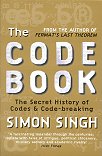Fermat wrote those words 350 years ago, and ever since his famous unproved "Last Theorem" has been a cause of strong fascination, and even stronger frustration, as mathematicians, professional and amateur alike, have failed to prove it. In more modern terminology, Fermat's statement is:
xn + yn = zn has no whole number solutions for n > 2
The BBC's Horizon is a TV series about modern scientific and technical advances. A recent programme was dedicated to Andrew Wiles' historic proof of Fermat's Last Theorem, and, perhaps surprisingly, it made fascinating viewing. Singh, one of the team who made the film, here writes up the story in more detail. He weaves together two stories: that of the theorem and the mathematical developments it has catalysed, and that of Wiles' developing passion for it. There are also the usual illustrations of the relevant mathematicians, along with facsimiles of the Annotated Arithmetica, with Fermat's famous marginalia, of Galois' frantic pre-duel scribblings, and of the first page of Wiles' proof (totally incomprehensible, of course).
Much of the early material should be familiar to anyone who has read a few history of mathematics books, but here it is told in more detail, as a single tale of one theorem, with a sense of mounting excitement, because this time we know there is to be a "happy ending". The latter half has the new material, and new drama. The story couldn't be more exciting if it had been scripted as a thriller: "One man alone on a quest, triumphantly gains his goal, and the story is over. But no! In a final twist, that goal proves false. A last desperate lunge, and the true goal is attained."
Some of the more peripheral material seems to me to be padding. But the main story is well told, deeply fascinating, with a genuine feeling of excitement -- I would have liked more of it, especially more technical detail. Any mathematical detail is relegated to Appendices, but even these are not as deep as many popularised mathematics books.
We get a real sense of excitement, and of elation, as the proof is finally completed. This is tempered with just a small sense of disappointment, that this 350-year-old quest, that has fired the imaginations of so many, is finally over. (The proof might never have come about had Wiles not had the opportunity, supplied at Princeton, to spend seven isolated years working on nothing else -- a lesson for today's "efficiency" ideas of requiring "industrial management" practices to be applied to university research.)
Singh makes clear is that, in order to do his >100 page proof of Fermat's Last Theorem, Wiles used much apparatus from modern number theory, and also produced much new deep mathematics himself. This proof does not just fill in a small, obscure, 350-year-old hole; it is a tremendous advance in number theory in its own right. Mathematicians are excited by it because it is actually a proof of the Taniyama-Shimura conjecture (which others had earlier proved implies Fermat's Last Theorem), and that conjecture is used as the basis for much other work in number theory.
Clearly, Wiles' 20th century proof cannot be Fermat's own alleged proof, restricted to 17th century mathematics. If Fermat really did have a proof, it must have been much simpler, and there is still a chance for someone to discover it. But if Fermat's own proof was flawed, as many believe, we should be thankful his copy of Diophantus' Arithmetica didn't have wider margins. For then the flaw would have been spotted very quickly, and this wonderful puzzle might never have resulted in such great mathematical advances.

